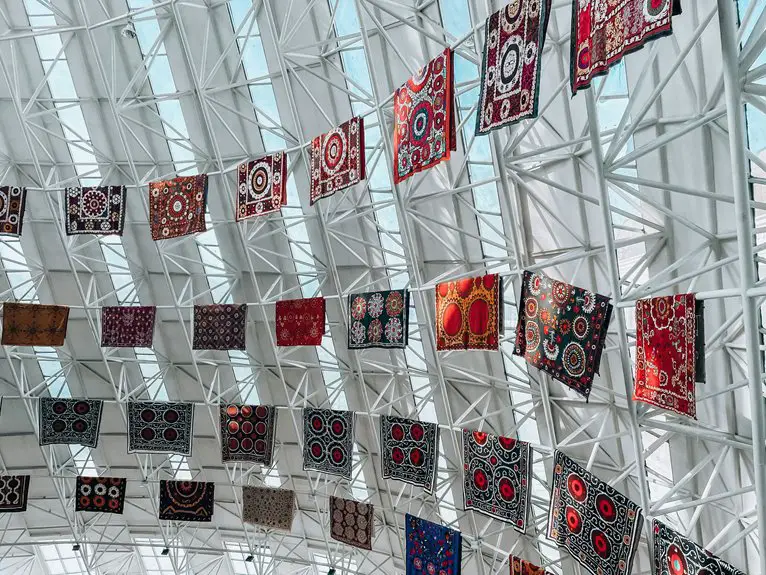You’ll notice Suzani and Ikat differ mainly in technique and style. Suzani, from Central Asia, is hand-embroidered with vibrant floral and medallion patterns on cotton or silk. Ikat, found in many cultures including Indonesia and India, uses a resist-dye process to create blurred, geometric designs by dyeing threads before weaving. Suzani feels bold and detailed, while Ikat appears softer and abstract. Keep exploring, and you’ll uncover how their cultural stories and uses vary widely.
Table of Contents
Key Takeaways
- Suzani is hand-embroidered fabric from Central Asia, while Ikat is a dyed textile created by resist-dyeing threads before weaving.
- Suzani patterns are sharp, floral, and symbolic, whereas Ikat features blurred, geometric, and abstract motifs.
- Suzani uses vibrant silk or cotton threads on a base fabric, contrasting with Ikat’s muted, blended colors from multiple dyeing rounds.
- Suzani holds cultural meanings of protection and fertility, often used in wedding gifts; Ikat represents tribal identity and spiritual beliefs.
- Suzani is popular in home decor, while Ikat is commonly used in clothing and upholstery, both blending tradition with modern style.
Historical Backgrounds of Suzani and Ikat
Although both Suzani and Ikat fabrics boast rich histories, they come from distinct cultural traditions that have shaped their unique styles.
When you look at Suzani, you’re stepping into Central Asia, especially Uzbekistan, where these embroidered textiles have been treasured since the 15th century. Suzani’s name means “needle” in Persian, reflecting the hand-stitched artistry passed down through generations, often made for weddings and special occasions.
On the other hand, Ikat has roots stretching across various cultures, from Indonesia to India and Central Asia. You’ll find Ikat’s story in ancient times, prized for its intricate dyed patterns created before weaving.
Both fabrics tell stories of their people, but their origins highlight contrasting cultural journeys that influence their look and significance today.
Techniques Used in Creating Suzani and Ikat
Craftsmanship defines both Suzani and Ikat, but their techniques couldn’t be more different.
Suzani and Ikat both showcase craftsmanship, yet their creation methods are uniquely distinct.
When you explore Suzani, you’ll see it’s all about hand embroidery. Skilled artisans use:
- A base fabric, often cotton or silk.
- Vibrant silk or cotton threads.
- Hand stitching methods like chain, satin, and buttonhole stitches.
- Layered, detailed embroidery to build rich textures.
Ikat, on the other hand, involves a dyeing process before weaving. You’ll find that:
- Threads are tightly bound in specific patterns.
- The bound areas resist dye, creating designs.
- Multiple dyeing and binding rounds form complex motifs.
- Finally, the dyed threads are woven to reveal the blurred, signature Ikat look.
Distinctive Patterns and Motifs
The unique techniques behind Suzani and Ikat directly shape their eye-catching patterns and motifs. When you look at Suzani, you’ll notice intricate floral and vine designs, often bold and symmetrical. Ikat, on the other hand, features blurred, geometric, and abstract patterns due to its resist-dyeing method.
| Feature | Suzani | Ikat |
|---|---|---|
| Pattern Style | Floral, Vines, Medallions | Geometric, Abstract |
| Edges | Sharp, Detailed | Soft, Blurred |
| Color Contrast | Bold, Vibrant | Muted, Blended |
| Symmetry | Balanced, Repetitive | Irregular, Random |
| Motif Inspiration | Nature, Traditional Symbols | Tribal, Cultural Abstracts |
You’ll find these differences give each fabric a unique visual identity.
Cultural Significance and Regional Variations
When you explore Suzani and Ikat fabrics, you’ll discover rich cultural stories woven into each piece that reflect their origins.
Suzani, mainly from Central Asia, often symbolizes protection and fertility, crafted as wedding gifts that carry blessings.
Ikat, found across Southeast Asia, Latin America, and India, connects deeply to tribal identity and spiritual beliefs.
Here’s what you should know about their cultural significance and regional variations:
- Suzani motifs vary by Uzbek, Tajik, and Kazakh regions, each with unique embroidery styles.
- Ikat techniques differ widely—from double ikat in Indonesia to single ikat in India.
- Suzani often uses silk threads; Ikat relies on resist-dyed yarns.
- Both fabrics serve ceremonial roles but highlight distinct cultural narratives you can feel in their textures.
Modern Uses and Popularity in Fashion and Home Decor
Although rooted in tradition, Suzani and Ikat fabrics have found fresh life in modern fashion and home decor, appealing to those who want to infuse their style with cultural richness.
You’ll see Suzani’s intricate embroidery on throw pillows, wall hangings, and bedspreads, adding vibrant patterns and texture to any space.
Ikat’s distinctive blurred designs grace dresses, scarves, and upholstery, offering a bold, artistic flair.
Both fabrics blend tradition with contemporary aesthetics, making them popular choices for designers and home decorators alike.
Whether you’re updating your wardrobe or redecorating your living room, using Suzani or Ikat pieces lets you celebrate heritage while staying on-trend.
Embracing these fabrics means you’re not just choosing style—you’re honoring centuries of craftsmanship and culture.
Frequently Asked Questions
How Do Care Instructions Differ Between Suzani and Ikat Fabrics?
Think of Suzani as a delicate painting: you’ll want to hand wash it gently to preserve its embroidery. Ikat, like a vibrant watercolor, can usually handle machine washing on gentle cycles but avoid harsh detergents to keep colors vivid.
Which Fabric Is More Durable, Suzani or Ikat?
You’ll find ikat fabric generally more durable because it’s tightly woven and dyed before weaving. Suzani, with its intricate embroidery, requires gentler care and isn’t as sturdy for heavy use or frequent washing.
Are Suzani and Ikat Fabrics Eco-Friendly or Sustainable?
Sustainability starts with the choices you make. Suzani and ikat are often eco-friendly since artisans use natural dyes and handcrafting methods, but always check sourcing to verify the fabrics truly respect the environment and support local communities.
Can Suzani and Ikat Fabrics Be Machine Washed Safely?
You shouldn’t machine wash suzani or ikat fabrics, as they’re delicate. Instead, hand wash them gently with cold water and mild detergent to preserve colors and embroidery, avoiding damage and shrinking.
What Are the Typical Price Ranges for Suzani Versus Ikat Fabrics?
You’ll find suzani fabrics typically range from $50 to $300 per yard, while ikat fabrics usually cost between $20 and $150. Prices vary based on craftsmanship, materials, and origin, so always check quality before buying.
- Does Chiffon Fabric Stink - July 15, 2025
- Does Chiffon Fabric Affect the Economy - July 15, 2025
- Does Cotton Fabric Have a Nap - July 15, 2025







